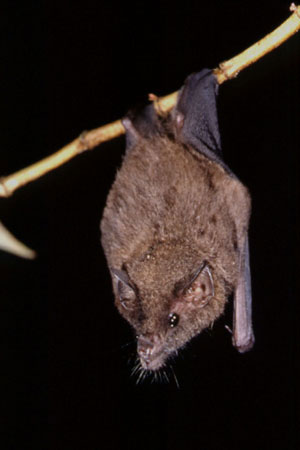
The New World leaf-nosed bats (Phyllostomidae) are found from southern North America to South America, specifically from the Southwest United States to northern Argentina. They are ecologically the most varied and diverse family within the order Chiroptera. Most species are insectivorous, but the phyllostomid bats include within their number true predatory species and frugivores. For example, the spectral bat, the largest bat in the Americas, eats vertebrate prey, including small, dove-sized birds. Members of this family have evolved to use food groups such as fruit, nectar, pollen, insects, frogs, other bats, and small vertebrates, and in the case of the vampire bats, even blood.

The white-winged vampire bat, a species of vampire bat, is the only member of the genus Diaemus. They are found from Mexico to northern Argentina and are present on the islands of Trinidad and Margarita.

The dark long-tongued bat is a species of bat from South and Central America. It was formerly considered the only species within the genus Lichonycteris, but is now recognized as one of two species in that genus, along with the pale brown long-nosed bat. It is small species of bat, with adults weighing 6–11 g (0.21–0.39 oz) and having a total length of 46–63 mm (1.8–2.5 in).

Dekeyser's nectar bat is a bat species found in Brazil and Bolivia.

Thomas's nectar bat is a bat species from South and Central America. Thomas's nectar bat pollinates the vine Marcgravia.

Anoura is a genus of leaf-nosed bats from Central and South America. Anoura members lack or have a short tail, and are nectarivorous bats of small to medium size among the Phyllostomidae.

Kalinowski's mastiff bat is a species of bat in the family Molossidae, the free-tailed bats. It is native to Peru and northern Chile. Relatively little is known about the species, but it is thought to be common in its range. It is sometimes seen in urban areas. Molecular sequencing data indicates that the closest relatives of M. kalinowski are members of another genus, Nyctinomops.

The Mexican long-tongued bat is a species of bat in the family Phyllostomidae. It is the only species within the genus Choeronycteris. The species is found in El Salvador, Guatemala, Honduras, Mexico, and the United States.

The long-snouted bat is a species of bat in the family Phyllostomidae. It is the only species within the genus Platalina. It is endemic to northern Peru and northern Chile. It feeds almost exclusively on the nectar and fruit of the columnar cactus. The species is rare, but has a wide distribution with at least 25 populations, and is listed as near-threatened due to habitat loss causing the removal of their primary food source.

Aratathomas's yellow-shouldered bat is a species of bat in the family Phyllostomidae native to South America.

The Bogotá yellow-shouldered bat is a species of bat in the family Phyllostomidae. It is found in Colombia, Ecuador, Peru, and Venezuela at altitudes from 300 m to above 2000 m, particularly in cloud forest. The species is primarily frugivorous; it may also consume nectar and pollen.

Glossophaginae is a subfamily of leaf-nosed bats.

James Lloyd Patton, is an American evolutionary biologist and mammalogist. He is emeritus professor of integrative biology and curator of mammals at the Museum of Vertebrate Zoology, UC Berkeley and has made extensive contributions to the systematics and biogeography of several vertebrate taxa, especially small mammals.

Dryadonycteris capixaba is a species of leaf-nosed bat found in South America. It is the only species within the genus Dryadonycteris
Lonchophylla orienticollina is a species of bat found in Colombia, Venezuela, and Ecuador.
Hsunycteris is a genus of bats in the family Phyllostomidae and the only genus in the tribe Hsunycterini.
Cadena's long-tongued bat is a bat species from Colombia and Ecuador. It was originally described in the genus Lonchophylla, but was moved to Hsunycteris when the latter was erected in 2014.
Patton's long-tongued bat is a bat species from Bolivia, Colombia, Ecuador, and Peru. It was originally described in the genus Lonchophylla, but was moved to Hsunycteris when the latter was erected in 2014.

Lonchophyllinae is a subfamily of leaf-nosed bats.













